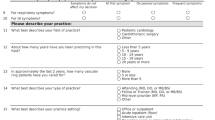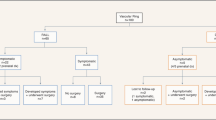Abstract
Our aim was to determine the presentation of patients with vascular rings and evaluate the effectiveness of investigations. Surgical outcomes and respiratory sequelae were also examined. The design was a retrospective case note study over a 13-year period set in a tertiary children’s hospital. Children below the age of 16 years presenting with a vascular ring to the Royal Hospital for Sick Children, Glasgow were studied. Demographic data at presentation, including symptoms, were recorded. The ability of diagnostic investigations to identify the presence of a vascular ring was evaluated. Surgical outcomes were determined by measuring surgical complications and mortality. Respiratory sequelae were recorded by the presence of persistent symptoms or the need for tracheostomy or long-term ventilation following surgery. A total of 24 patients were identified with a median age at presentation of 4.5 months. Stridor was the commonest presenting symptom (14/24). Angiography, chest CT scanning and MRI were the most accurate imaging modalities (accurate in 100% of cases used). Chest X-ray films and echocardiography had the lowest detection rates. Surgical complications (4/24) and mortality (1/24) were low. A substantial number of patients available to follow-up (7/20) were still experiencing stridor 3 months post-operatively. Conclusion:Vascular rings are rare, however, often present with common symptoms. Most children present in early infancy, but a minority presents much later. The investigation of choice is a barium swallow followed by high-resolution computed tomography. Surgery is safe although a number of patients will have persisting symptoms.





Similar content being viewed by others
References
Bakker DAH, Berger RMF, Witsenburg M, Bogers AJJC. (1999) Vascular rings: a rare cause of common respiratory symptoms. Acta Paediatr 88: 947–952
Chun K, Colombani PM, Dudgeon DL, Haller JA Jr (1992) Diagnosis and management of congenital vascular rings: a 22-year experience. Ann Thoraci Surg 53: 597–602
Klinkhamer AC (1969) Esophagography in anomalies of the aortic arch system. Williams and Wilkins, Baltimore
Lillehei CW, Colan S (1992) Echocardiography in the preoperative evaluation of vascular rings. J Pediatr Surg 27: 1118–1121
Lowe GM, Donaldson JS, Backer CL (1991) Vascular rings: 10-year review of imaging. Radiographics 11: 637–646
Stewart JR, Kincaid OW, Edwards JE (1964) An atlas of vascular rings and related malformations of the aortic system. Charles C Thomas, Springfield, p 111
Valleta EA, Pregarz M, Bergamo-Andreis IA, Boner AL (1997) Tracheoesophageal compression due to congenital vascular anomalies (vascular rings). Pediatr Pulmonol 24: 93–105
Van Son JA, Julsrud PR, Hagler DJ (1993) Surgical treatment of vascular rings: the Mayo Clinic experience. Mayo Clinic Proc 68: 1131–1133
Author information
Authors and Affiliations
Corresponding author
Rights and permissions
About this article
Cite this article
Turner, A., Gavel, G. & Coutts, J. Vascular rings—presentation, investigation and outcome. Eur J Pediatr 164, 266–270 (2005). https://doi.org/10.1007/s00431-004-1607-6
Received:
Accepted:
Published:
Issue Date:
DOI: https://doi.org/10.1007/s00431-004-1607-6




